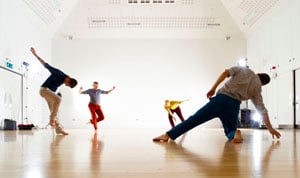When artists move in
Sarah Brigham explains how the artistic spirit thrives and opportunities multiply when artists inhabit their own creative space

Prior to the opening of The Creation Space in November 2009 four questions preoccupied us at The Point:
- How do we support and encourage the limitless ambition of an artist to make great work, helping them to feel safe enough to take risks and push their own practice?
- How do we encourage artists to have their audience in their minds’ eye from the start, and how do we encourage them to engage with that audience throughout the process of making rather than just at the end point of presenting?
- As a presenting arts centre which often shows work for one night only, how do we deepen our audiences relationship with artists when they are here?
- How do we retain artists in the region when London is only one hour away on the train?
Thanks to a £2.7m investment by the local authority, and an inspirational Head of Culture, who pushed through the idea after reading about choreographic centres in France, The Creation Space was built at The Point to address these issues. It houses up to 11 artists, living and making their work in a state-of-the-art rehearsal studio with integrated accommodation. Artists have 24-hour access to the space and at the end of their residencies – which last anything from one to ten weeks – often transpose their work onto our stage. The studio is double heighted allowing for aerial work, has a sprung dance floor and is filled with natural light but also benefits from complete blackout facility.
Recent funding support from Arts Council England and Esmée Fairbairn Foundation has enabled us to offer artists the chance to use this incubator to extend their practice in new and innovative ways. When artists start their working day with a 20-second walk from the breakfast table to the studio, and end it by eating a shared meal together and having a two-minute walk to their bedrooms, rather than a long journey on a packed bus or train, creativity is allowed to flourish. One company commented recently: “Staying and working in the facility made the creative process feel entire; you are able to live and breathe the work with the artists you are working with.” The benefits are not only felt by the artists: our audiences suddenly have artists literally living in their midst. Open rehearsals, artist discussions, workshops, participation work are now all possible with artists of an international calibre who previously may have visited for just one night.
Today, as Lîla Dance move into week three of their residency, the blackout screens are up and the large windows overlooking the sunbathed park fill the space with light. Our conversation turns to the people who are walking their dogs, meeting their friends or having their lunch. How do we engage these people in this work? Can we invite them in to see the work in its raw form now; can we engage further with them digitally by broadcasting an interview with the choreographer or dancers? Artists have a natural curiosity for people and when they can settle in one creative space for some time, the audience can be invited into the process sooner rather than later in a much easier way.
For the organisation the benefits are endless – firstly, a transformation of culture. We have moved from being a presenting house, having shows truck in and out in one day, to being a producing hub. Work is made here and our staff have a real connection to the artists who make it – who often greet us in their pyjamas as we pass by. As I sit in the café bar and hear our box office and bar staff talk to our audiences about the work that is being made, I am constantly amazed at how well informed they are. It’s as if by placing the artists at the centre of the organisation, the energy and knowledge runs into the blood of every one of us.
We’ve been able to open our doors to artists from around the world without the concern of prohibitive hotel bills. International work can be made and toured from here, such as Teatr Piesn Kozla’s Macbeth which opened here, toured the UK, and finished with a three-week run at the Barbican. We’ve also been able to make our own work too – firstly through our Associate Artists’ scheme, through which we offer business and artistic support, office and rehearsal space to emerging artists to help them develop and produce their first shows; and secondly, through our own shows for young audiences.
Our ambition now is to further explore the triangle of artist/venue/audience, opening the space to a global platform digitally, for example through streamed interviews and conversations online. We’ve already invited artists and local audiences essentially to move in with us; now we’d like to extend that invitation even further and develop a conversation around what ‘engagement’ really means – and how it can benefit both.
Join the Discussion
You must be logged in to post a comment.